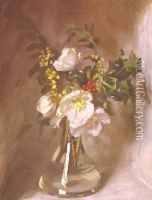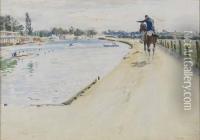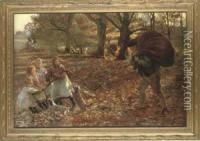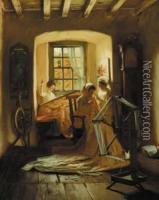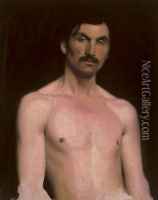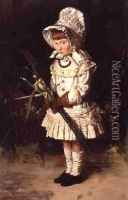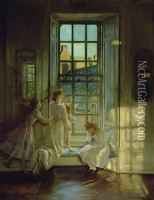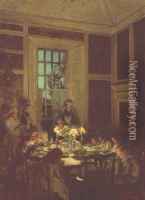John Henry Lorimer Paintings
John Henry Lorimer was a Scottish painter who gained recognition for his portraits, domestic scenes, and depictions of interiors. Born on August 27, 1856, in Edinburgh, Scotland, Lorimer came from a family with a strong interest in the arts. His father, James Lorimer, was a professor of public law at Edinburgh University, and his brother, Robert Lorimer, became a well-known architect.
Lorimer studied at the Royal Scottish Academy schools from 1875 to 1878 and then proceeded to study at the Royal Academy in London. His education was supplemented by his travels to Paris and Spain, where he was influenced by contemporary European art movements and techniques. He also spent time in Rome, where he was particularly taken with the work of the Old Masters.
During his career, Lorimer achieved success and was known for his fine attention to detail, use of light, and the warmth he brought to his subjects. His most famous work is 'The Flight of the Swallows' (1887), which exemplifies his skill in using light to create atmosphere. He often painted scenes of everyday life, creating a sense of tranquility and beauty in his compositions. Lorimer's work also reflects his interest in capturing the effects of sunlight and shade, a theme that recurs throughout his oeuvre.
Lorimer was elected a member of the Royal Scottish Academy in 1882 and later served as a member of the Royal Scottish Watercolour Society. He exhibited frequently and his work was well received by both the public and critics. Despite his success, Lorimer remained relatively conservative in his artistic approach, maintaining a commitment to realism and often resisting the more avant-garde movements of his time.
Lorimer's contributions to Scottish art were significant, and his works can be found in many public collections, including the National Galleries of Scotland. His legacy is one of capturing the quiet elegance of domestic life and the play of light within interior spaces.
Lorimer passed away on November 4, 1936, in Edinburgh. His work continues to be celebrated for its contribution to the tradition of Scottish painting and its evocative portrayal of the simple, yet profound moments of everyday life.
